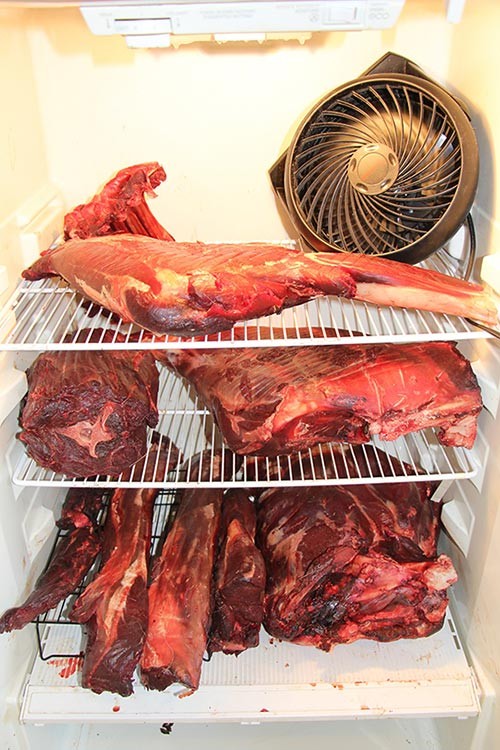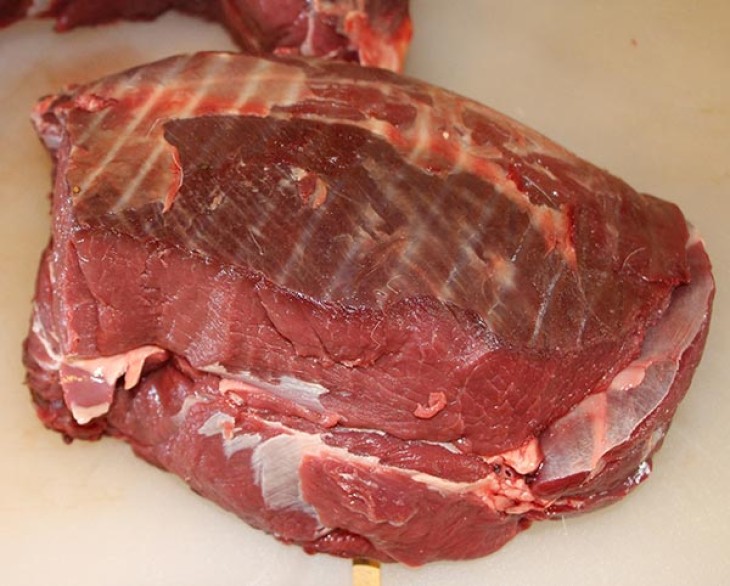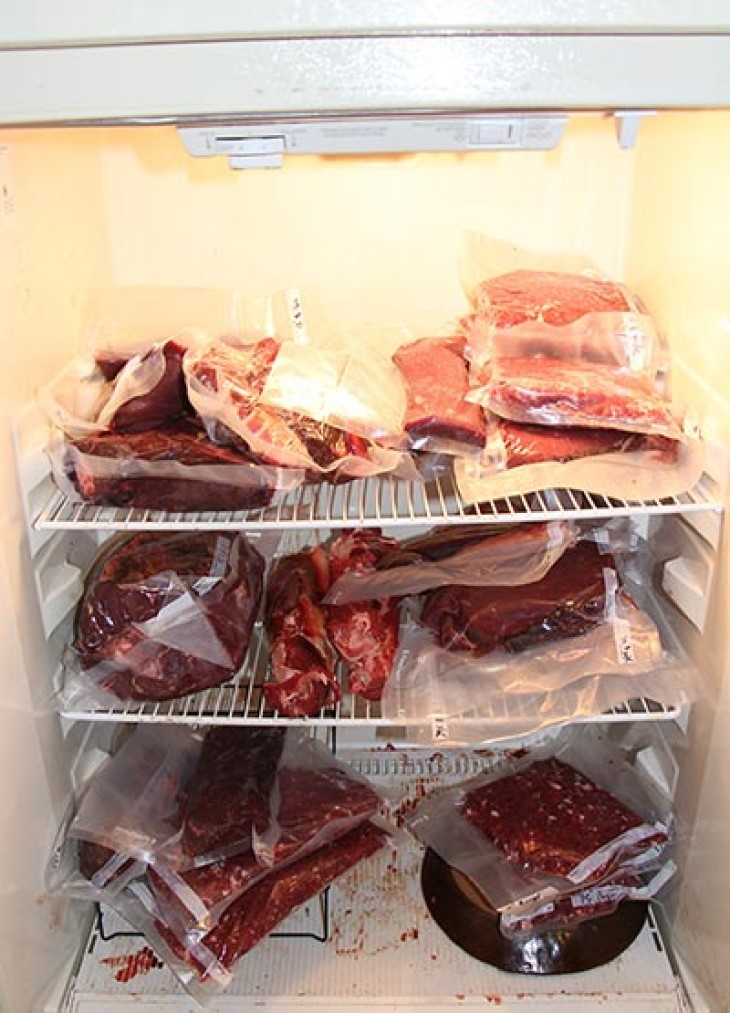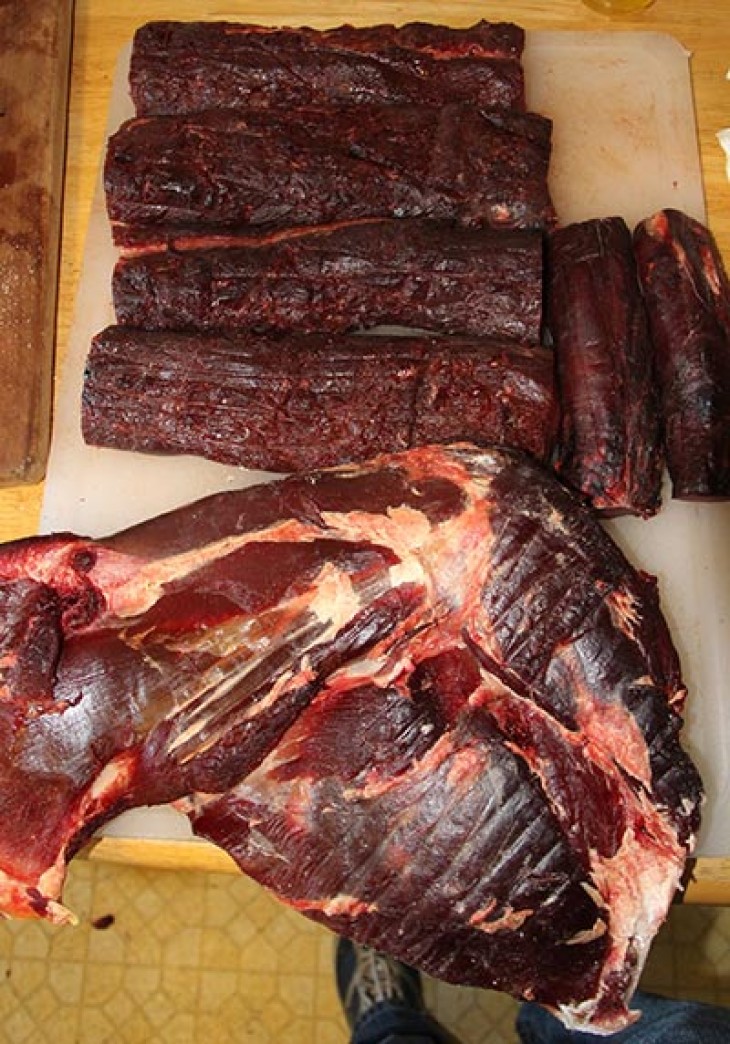We hung a grizzled old deer in camp this year who was in less than ideal condition, meat-wise. He was sort of randy smelling in general – just all rutted up and glandular. That a shot hit him low in the body cavity didn’t help the odor, nor did 10 hours of dragging him in too-warm-for-deer-season heat, or the 22 hours it took before we could get the meat in the refrigerator.
If 20-year-old me had seen and smelled the deer as we butchering him, I would have been sure that he was going to be tough on account of his age, and gamey tasting on account of the heat. But 40-year-old me has learned a few things about putting up venison that I’ll share for those of you who might be new to hunting or butchering. I’m no expert, but I have been tinkering with this sort of thing for two decades now. If you have your own experiences to share, or if you see any flaws in what I’m about to write, by all means add to the story in the comment section below. The more collective wisdom we have, the better the document becomes.
So. Step one of knowing how to break the rules with your venison is knowing what the rules are to begin with. In a perfect world, you’d kill a deer when it’s between 35 and 40 degrees out, process in a sterile environment, hang the carcass in a place with a steady 38 degree temperature and a relative humidity of 75 percent for two or three weeks, then make your cuts and enjoy.
You’ve probably never seen such consistent weather, and you probably don’t own a meat locker, so the goal is just conform to this as closely as you can. Meat taints from the guts out, so remove the entrails immediately. If it’s a warm day, cut out the trachea and the hemal nodes (those little dots around the trachea), too, as they can spoil the neck meat. Get the deer as open as possible so the body heat can dissipate.
Barring freak heat, you shouldn’t have much to worry about on the first day in northern New England, since it takes a while for the animal heat to leave the body, and by then it’s usually nighttime and conditions are appropriately cool. It’s the sun and warmth of the next day that you have to watch out for. If it’s above 40 degrees, ice the deer if you can’t process it immediately, and get to it as fast as you can. Don’t be stupid and drive around with the buck needlessly in the back of your truck, but don’t be scared if it’s warmish and it takes you a day or two – the carcass can take more than you think. (I should add a disclaimer here that bears are much different than deer on account of all their winter fat. A bear carcass can handle less time and temperature, and should be treated like a hog – the hide and fat should be removed as soon as possible, and the meat processed quickly. Aging a bear like a beef or like venison is not advised.)
Once the deer is home, skin it and make your primary cuts. The dangerous bacteria in the animal is in the body cavity with the guts and the feces, so I use one knife for skinning and cavity work and a separate knife for cutting meat. If there’s any question, I wash the blade. I bone out most of my venison, leaving only the neck, ribs, and shanks bone-in. Where there is bone, I chime the ends. I’ve used Seventh Generation multi-purpose cleaner as a disinfectant on all processing surfaces for the last few years and have never had a problem getting sick. I used to use a bleach solution and that worked, too, but I like the idea of a plant-based disinfectant for food surfaces and the reviews of the Seventh Generation product checked out.
The next step is deciding if you want to wet-age or dry-age the meat. Either will improve the quality of any venison, but the trick is especially important with tough, old deer. Both methods work as a means of tenderizing, though dry-aging has a more pronounced effect on the meat’s flavor. It’s a little trickier/riskier, but to my palette it’s worth it.
To wet-age, simply proceed with cutting the meat up. Vacuum seal your packages, then put them in the refrigerator and keep at around 38 degrees for a few weeks. You can do this before you freeze the meat, or after you take the meat out of the freezer. I’ve only wet-aged in vacuum-sealed packages, so I can’t vouch for any other method. I personally would only age meat that has been vacuum-sealed, but this is based on intuition, not fact. Because we’re an educational outfit I should throw in here that the USDA Food Safety and Inspection Service states that raw venison should be kept in the refrigerator for no more than three to five days, so if you’re the type who craves rules, there’s one. On the flip side, there’s a long culinary tradition that stretches back thousands of years related to aged meat – in nineteenth-century Europe, it was all the rage among gastronomes to let beef literally rot on the outside before it was eaten – so there you have your two extremes.
To dry-age, I use an old refrigerator that I keep on hand for the task. I plug it in, disinfect it, get it to temperature, then add the primary cuts. The venison pictured in the opening shot is 14 days old. Note the fan; it’s there on advice from a professional butcher. The circulating air helps form that nice burgundy-colored crust, which seems to limit mold. Note, too, how I’m just using racks. (That ham on the bottom right is propped up on a small plate to get it off the crisper tray.) This works, but is not ideal. I think next year I’m going to try drilling holes and adding a rod through the sides of the refrigerator; if I reinforce the rod on the outside with vertical bracing that holds the weight, I think I’ll be able to hang the meat and get better air flow. If you have any experience with this please share.
Temperature and air-flow seem key. In my years of experimenting with this sort of thing my biggest mistakes have all involved leaving meat on meat. Once, I left two bacons stacked on top of each other, and in just one night’s time had the fat go green and rancid. Aged rib sections stacked bone on bone – same problem. I tried aging a bowl of stew meat once, and it soon had mold and discoloration and a bad odor. The lesson I took from this is that you want to age the meat as big primary cuts, and you want air circulation.
The other trick is learning to use your nose and eyes. Taint will smell like taint – a rotten odor. Aged meat smells, but it’s more like an earthy cheese smell. The meat changes color, but it’s all on the red or purple color spectrum, not brown or gray – which indicates rot. The crust on aged meat smells a little like jerky. Sometimes white whispy mold does form, but I’ve never had a problem just brushing or cutting it off. I wouldn’t encourage the mold – it probably means you’re playing with the edge – but I wouldn’t fear it in moderation. A primary cut is dense like cheese, so below the surface things are usually fine. Plus, when you cook the meat, any surface funk will be killed.
So why do all this? Flavor and tenderness. When an animal dies, the control systems in its cells stop functioning, and enzymes begin attacking and turning flavorless molecules into smaller, flavorful fragments. They break proteins into delicious amino acids, glycogen into sweet glucose, adenosine triphosphate into savory inosine monophosphate. The meat takes on a concentrated, almost nutty flavor. At the same time, the enzymes are weakening the collagen in the connective tissue, which causes it to dissolve into gelatin during cooking, thus making the meat more tender; it also reduces the squeezing pressure that the connective tissue exerts during heating, which means the meat loses less moisture during cooking. All of this smart-sounding food science stuff was cribbed from Harold McGee’s On Food and Cooking.
As you butcher the aged meat, the tenderness will be obvious. The meat will be slumping away from the bone. You’ll be able to hand-pull the fat and membrane off the bottom of the backstraps. You’ll be able to run muscly leg meat through your weak meat grinder and not have the blade bind up every two minutes with connective tissue.
Fourteen days was long enough for this old buck’s backstraps – the crust on the meat was starting to get hard. We butterflied one and layered high-end prosciutto, and fresh basil, and crumbly cheddar and parmesan onto one half, then closed the meat like a book. Tied it up with twine. Grilled to medium rare over hardwood coals. Let the meat rest for ten minutes or so before cutting in to it. Italian-style medallions of meat on a plate, now, next to squash and sweet corn from last summer’s garden. Pride and a sense of ownership of most of what’s on the table. Prayers of thanks, and hunting stories about the noble animals we pursue. These are moments when everything seems right with the world.






Discussion *